The Present Continuous Tense for future use
- 格式:ppt
- 大小:465.00 KB
- 文档页数:22

PresentContinuous/ProgressiveTense1. Weusethepresentcontinuoustensetotalkaboutthingsthatarehappeningnow.2. Structure:1) Thepresentprogressivetense(alsosometimescalledthe"presentcontinuous*)isformedwiththepresenttenseoftheverbtobe+amainverb+-ing(bedoing),asin,"Heisconstantlycallingme,"or;"Theneighborsareplayingtheirmusicreallyloudly.,2) TheformationofthePresentParticiple:3) Add"-ing"directly:say—saying,play—playing,study-studying;4) Iftheverbisendedwith-e,thenremove"e"andadd-ing:love-loving,make—making,guide~~guiding,date一dating;5) Iftheverbisendedwith stresseddosedsyllable,thendoubletheIaStletterandadd-ing:begin—beginning,regret—regretting,run—running;6) Iftheverbisendedwith-ie,thenChange"ie"into"y"andadd-ing:lie—lying,die-dying,tie-tying.3. TemporalAdverbiaKphraseslike"rightnow"or*afthemoment"often indicatethatanactioniscurrentlyinprogress.4. BasicSentencePatterns:•Positivesentence:Tomiseatinganapple.•Negativesentence:Tomisnoteatinganapple.•GeneralquestionlsTomeatinganapple?Yes,heis./No,heisn,t.•Specialquestion(wh-question):-WhatisTomeating?-Apple.5. TheUsage:Weusethepresentprogressivetenseto■Talkaboutanon-goingactionthat'Shappeningrightnow.Forexample:They'rehavingameeting.■Describeanactionthatshappeningar。
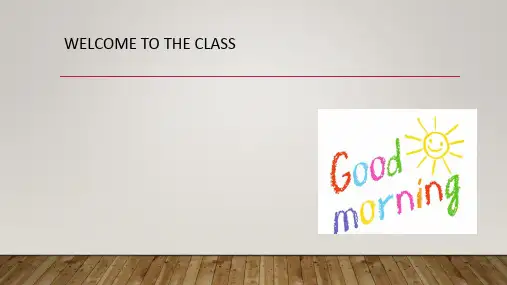
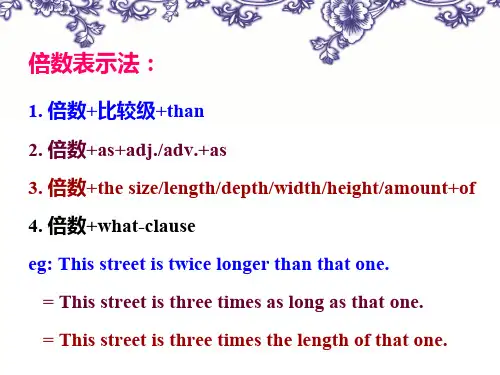
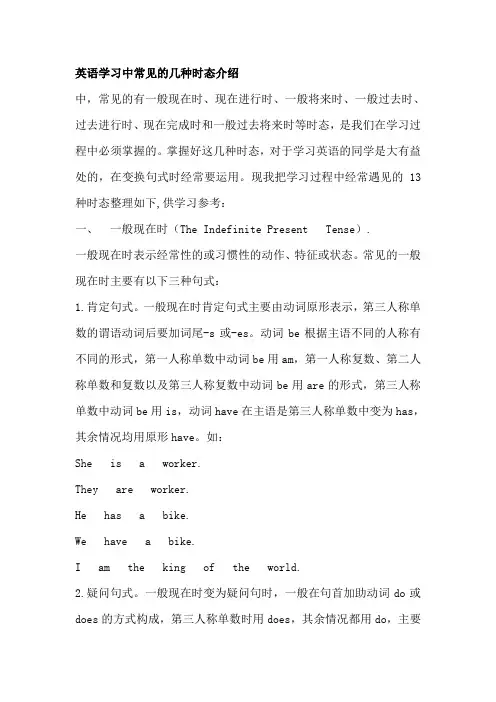
英语学习中常见的几种时态介绍中,常见的有一般现在时、现在进行时、一般将来时、一般过去时、过去进行时、现在完成时和一般过去将来时等时态,是我们在学习过程中必须掌握的。
掌握好这几种时态,对于学习英语的同学是大有益处的,在变换句式时经常要运用。
现我把学习过程中经常遇见的13种时态整理如下,供学习参考:一、一般现在时(The Indefinite Present Tense).一般现在时表示经常性的或习惯性的动作、特征或状态。
常见的一般现在时主要有以下三种句式:1.肯定句式。
一般现在时肯定句式主要由动词原形表示,第三人称单数的谓语动词后要加词尾-s或-es。
动词be根据主语不同的人称有不同的形式,第一人称单数中动词be用am,第一人称复数、第二人称单数和复数以及第三人称复数中动词be用are的形式,第三人称单数中动词be用is,动词have在主语是第三人称单数中变为has,其余情况均用原形have。
如:She is a worker.They are worker.He has a bike.We have a bike.I am the king of the world.2.疑问句式。
一般现在时变为疑问句时,一般在句首加助动词do或does的方式构成,第三人称单数时用does,其余情况都用do,主要动词一概不变,用原形;在以have或has为主要动词的句子中,可以直接将动词have或has提前放于句首,也可以在句首加动词do或does构成,have或has一律用原形have。
如:Do you work?Does he work?Has she a cake?Does she have a cake?其简略回答形式用“Yes+主语+动词”或“No+主语+动词+not”。
如:Yes, I do.No, he does not.Yes, she hasNo, she has not.3.否定句式。
一般现在时的否定句式在动词前加do/does not的形式构成。
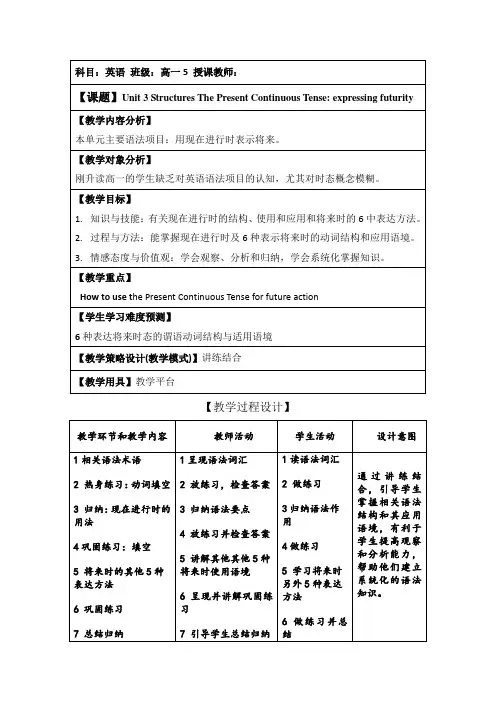
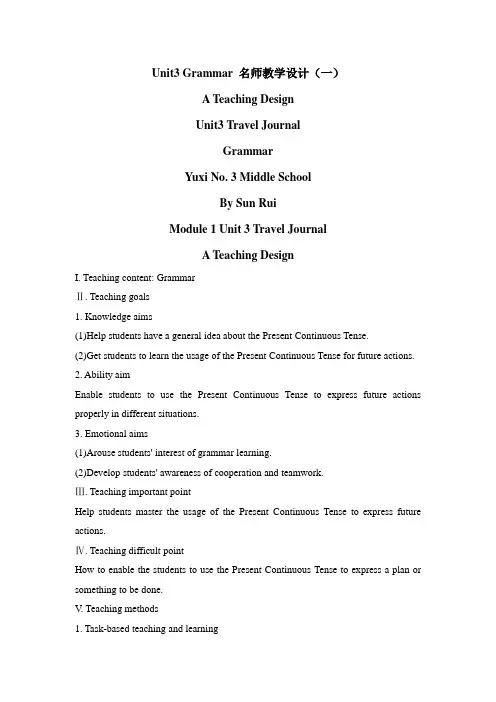
Unit3 Grammar 名师教学设计(一)A Teaching DesignUnit3 Travel JournalGrammarYuxi No. 3 Middle SchoolBy Sun RuiModule 1 Unit 3 Travel JournalA Teaching DesignI. Teaching content: GrammarⅡ. Teaching goals1. Knowledge aims(1)Help students have a general idea about the Present Continuous Tense.(2)Get students to learn the usage of the Present Continuous Tense for future actions.2. Ability aimEnable students to use the Present Continuous Tense to express future actions properly in different situations.3. Emotional aims(1)Arouse students' interest of grammar learning.(2)Develop students' awareness of cooperation and teamwork.Ⅲ. Teaching important pointHelp students master the usage of the Present Continuous Tense to express future actions.Ⅳ. Teaching difficult pointHow to enable the students to use the Present Continuous Tense to express a plan or something to be done.V. Teaching methods1. Task-based teaching and learning2. Cooperative learning3. DiscussionVI. Teaching aids:1. The multi-media2. The blackboardVII. Teaching ProceduresStep 1 GreetingGreet the students as usual.Step 2Lead-in1. Show the pictures of some activities on the screen and ask the students to answer the question “What is she/he doing?”【设计意图】通过观看与各种活动有关的图片,说出图片中的人物正在做什么,调动学生的热情,激起学生的学习兴趣,为本节课创设良好的开端。
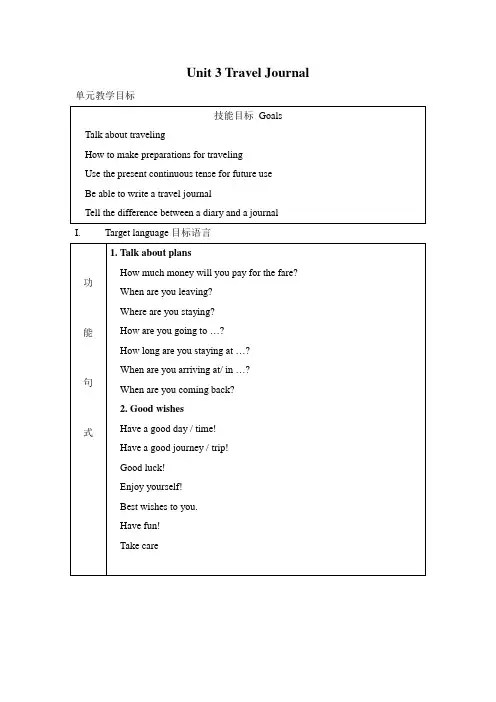
Unit 3 Travel Journal 单元教学目标I.Target language目标语言Ⅲ教材分析与组合1. 教材分析本单元以travel为主题,使学生通过travel了解他们所去国家或地区的风土人情,地理地貌及气候特征。
让学生体会英语作为工具给他们带来的乐趣。
学生可以利用英语扩大自己的视野,获取知识,了解世界。
学生可以通过相互讨论和相互交流以丰富各自的地理知识。
进一步扩大学生的词汇量。
能正确使用现在进行时的形式表达将来的计划和安排。
本单元把Travel Down the Mekong分成六部分,其中三部分作为阅读材料而另三部分作为听力材料。
通过本单元的学习使学生掌握一些重要词汇及词组,并能够写出自己的旅行日志来提高自己的写作水平。
1.1 Warming-up 让学生想象去旅游并选择一个地方为题,讨论所需费用,并决定四种交通方式,使学生了解旅行前的准备及计划。
1.2 Pre-reading 部分的三个问题是通过讨论河流在人民生活中的作用以及看图回答问题,让学生找到湄公河流域的国家,作为阅读的“热身”1.3 Reading 是日志的第一部分,它讲述了王坤和王薇的骑车旅行梦想和计划,描述了他们为这次旅游所做的准备,对旅游路线的选定以及他们通过查阅地图对湄公河情况的了解。
文章用第一人称的方式,通过对王薇做事的方式的介绍,让大家了解了她的性格特点,使人倍感亲切,给人留下深刻的印象。
日志的第二部分放在workbook 中,主要讲述他们在西藏山中度过的一宿,以及旅行中的苦与乐。
1.4 Comprehending第一题是信息题,通过问答使学生进一步理解课文以训练学生获取信息的能力。
第二题是理解题,让学生用自己的话解释课文中的句子。
第三题是推断题,让学生通过主人公的行为来推断他们对旅行的态度。
第四、五题是语言运用题,用以提高学生运用语言的能力。
1.5 Learning about language分两部分,第一部分是旨在通过三个题型的练习使学生掌握目标语言。
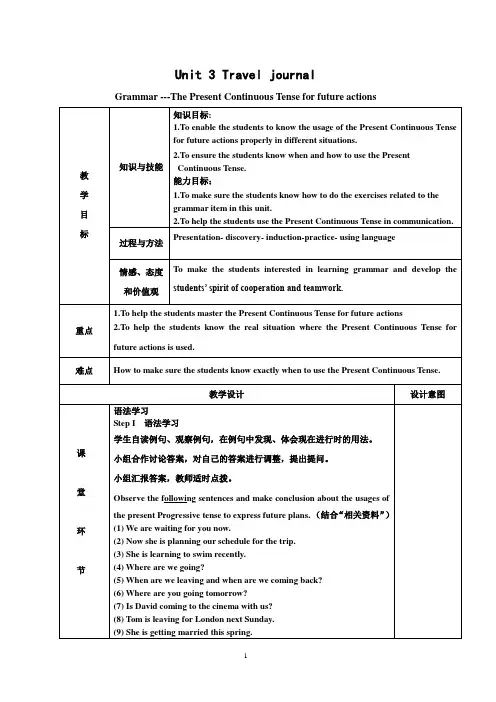

高中英语语法全英详解无水印IMB standardization office【IMB 5AB- IMBK 08- IMB 2C】必修一语法点一:Be+表将来 use the present continuous tense for future plans In English, we have lots of ways of talking about the future. The most common ways of talking about the future we encounter use ‘will’ or ‘be going to’ followed by an infinitive (动词原形), and we tend to use ‘be going to’ most often for talking about future plans.Sometimes, we also use the present continuous tense to talk about future plans.Ex. ①we are going to Mexico next Sunday.② Are you coming to the cinema?③ He is leaving for London in two hours.④ We are spending next winter in Australia.Only some verbs can be used in this situation, such as: go, arrive, come, leave, start, stay, return, play, have, work, wear, spend, see, meet, etc.扩展:What’s the difference between using ‘be going to’ and the present continuous to talk about future plans Let’s look at some more examples:“I’m going to play football on Saturday”You have made a plan in your head but possibly not taken any real action to confirm it. Also, playing football on Saturday is probably not a regular event for you.“I’m playing football on Saturday”You have made a plan and taken some real action to confirm it . called your friends or booked a place to play). In this case, it’s likely that playing football on Saturdays is a common activity for you.语法点二:Direct speech and indirect speech(直接引语和间接引语)Let's first define the terms, then look at how to talk about what someone said, and how to convert speech from direct to indirect or vice-versa.You can answer the question What did he say? in two ways:by repeating the words spoken (direct speech)by reporting the words spoken (indirect or reported speech).Direct speech repeats, or quotes, the exact words spoken. When we use direct speech in writing, we place the words spoken between quotation marks (" ") and there is no change in these words.Reported or indirect speech is usually used to talk about the past, so we normally change the tense of the words spoken. We use reporting verbs like 'say', 'tell', 'ask', and we may use the word 'that' to introduce the reported words. Quotation marks are not used.1、declarative sentence陈述句①Change in pronoun: The pronoun (subject) of the reported speech is changed according to the pronoun of reporting verb or object (person) of reporting verb (first part of sentence). Sometimes the pronoun may not change.In following example the pronoun of reported speech is “I” which will be ch anged in indirect speech into the pronoun (Subject) of reporting verb that is “he”.He said, “I like it very much.”→He said that he liked it very much.②Change in tense: If the first part of sentence (reporting verb part) belongs to past tense the tense of reported speech will change. If the first part of sentence (reporting verb part) belongs to present or future tense, the tense of reported speech will not change.③Change in demonstrative pronoun指示代词, temporal adverbial时间状语, adverbial of place地点状语 and verbs.Ps:(1)if the direct speech indicates objective truth, then there is no change in tense when it’s converted to indirect speech.Ex. He said, “Light travels much faster than sound.”→He said that light travels much faster than sound.(2) 如果在当地转述,here不必改成there,come不必改为go,如果在当天转述,yesterday, tomorrow等时间状语也不必改变。
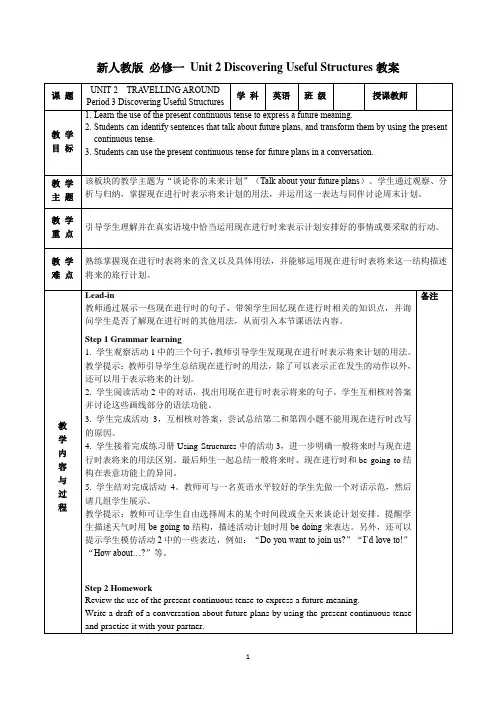
新人教版必修一Unit 2 Discovering Useful Structures教案课题UNIT 2 TRA VELLING AROUNDPeriod 3 Discovering Useful Structures学科英语班级授课教师教学目标1. Learn the use of the present continuous tense to express a future meaning.2. Students can identify sentences that talk about future plans, and transform them by using the present continuous tense.3. Students can use the present continuous tense for future plans in a conversation.教学主题该板块的教学主题为“谈论你的未来计划”(Talk about your future plans)。
学生通过观察、分析与归纳,掌握现在进行时表示将来计划的用法,并运用这一表达与同伴讨论周末计划。
教学重点引导学生理解并在真实语境中恰当运用现在进行时来表示计划安排好的事情或要采取的行动。
教学难点熟练掌握现在进行时表将来的含义以及具体用法,并能够运用现在进行时表将来这一结构描述将来的旅行计划。
教学内容与过程Lead-in教师通过展示一些现在进行时的句子,带领学生回忆现在进行时相关的知识点,并询问学生是否了解现在进行时的其他用法,从而引入本节课语法内容。
Step 1 Grammar learning1. 学生观察活动1中的三个句子,教师引导学生发现现在进行时表示将来计划的用法。
教学提示:教师引导学生总结现在进行时的用法,除了可以表示正在发生的动作以外,还可以用于表示将来的计划。
2. 学生阅读活动2中的对话,找出用现在进行时表示将来的句子。
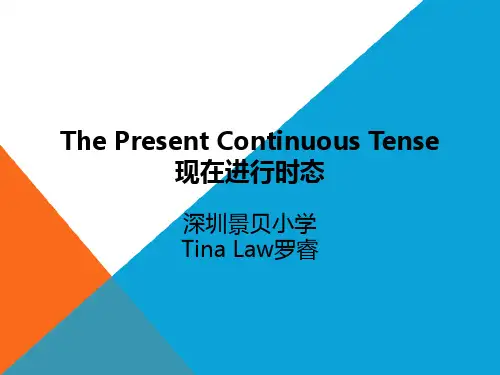
The Present Continuous T ense to express future actions.The analysis of the teaching material:3.Learning about language: In this part, students will discover useful wordsand expressions and also learn useful structures---- the PresentContinuous T ense to express future actionsing language: Present how to write a travel journal and then practisewritingTeaching goals1.T o revise the useful words and expressions.2. T o learn useful structures--- the Present Continuous T ense to express futureactions.Teaching important pointsthe Present Continuous T ense to express future actions.Teaching difficult pointsHow to use the Present Continuous T ense to express a plan or something to be done according to plan..Teaching aidsa projector and a computer1.T o revise the useful words and expressions.2. T o learn useful structures--- the Present Continuous T ense to express futureactions.Teaching important pointsthe Present Continuous T ense to express future actions.Teaching difficult pointsHow to use the Present Continuous T ense to express a plan or something to be done according to plan..Teaching aidsa projector and a computerStep 1:Greeting :A song.Step 2:Practice一、Use the reading passage to find the correct word or expression for each of the following sentences.1.He is so stubborn that no one can ____________ him to do anything.2.A ___________ person always tries to finish the job, no matter how hard it is. Answer: 1.persuade 2.determined3.Once; change her mind二、Match the words and the meaningsvalley a high place from which a river suddenly goes down.plain a fast-moving part of a river.waterfall a long, low, wide place between hills.delta the long place where a river enters the searapids a large body of ice moving slowly down a high valley三、Complete this passage with some of the above words.I really enjoyed my school field trip in geography. We saw so many beautiful things: a _________ thatflowed like a river of ice through a _______ that cut the mountains into two parts. We also discovered a river which fell off the mountains and become a wonderful __________this was even more exciting to see than the _______ where the water seemed to boil. Later we followed the river to a quieter ______ and finally into a ______ and the sea.Enjoy a song to present the Present Continuous T ense:I'm babysitting on ThursdayWould you like to go out on Monday?No, sor ry, I can’tWhy not?I’m babysitting on Monday.Would you like to go out on Tuesday?No, sorry, I can’t.Why not?I’m doing my laundry on Tuesday.Would you like to go out on Wednesday?No, sorry, I can’t.Why not?I’m working overtime on Wednesday.Would you like to go out on Thursday?No, sorry, I can’t.Why not?I’m working out on Thursday.Would you like to go out on Friday?No, sorry, I can’t.Why not?I’m visiting relatives on Friday.Would you like to go out on the weekend?Well… maybe!Ask the Ss to answer: What is she doing on Monday/Tuesday…?The Present Continuous T ense for future useThe present continuous tense can be used to express a plan or an arrangement.现在进行时可用来表示一个在最近按计划或打算要进行的动作;通常带一个表将来的时间状语, 但有明确的上下文时无须指出时间。
高中英语九大时态总结归纳英语时态是英语语法中非常重要的一个概念,掌握好时态不仅对于学习英语的人来说是至关重要的,而且在日常交流中也非常实用。
在高中英语中,涉及的时态较多,本文将对高中英语九大时态进行总结归纳,以帮助读者更好地掌握和运用这些时态。
一、一般现在时(Simple Present Tense)一般现在时表示经常性的动作、习惯、真理等,常常使用的时间状语包括always, usually, often, sometimes等。
一般现在时的肯定句结构为:“主语 + 动词原形(第三人称单数加-s)+ 其他”,否定句为:“主语 + do not / does not + 动词原形”,疑问句为:“Do / Does + 主语 + 动词原形”。
例句:1. He always studies hard for exams.(他总是努力学习备考。
)2. We don't like to eat spicy food.(我们不喜欢吃辣的食物。
)3. Does she live in New York?(她住在纽约吗?)二、一般过去时(Simple Past Tense)一般过去时用于表示过去某个时间发生的动作或存在的状态,常常使用的时间状语有yesterday, last night, ago等。
一般过去时的肯定句结构为:“主语 + 动词过去式 + 其他”,否定句为:“主语 + did not + 动词原形”,疑问句为:“Did + 主语 + 动词原形”。
1. I visited my grandparents last weekend.(我上周末去看望了我的祖父母。
)2. They didn't go to the cinema yesterday.(他们昨天没去电影院。
)3. Did you finish your homework?(你完成作业了吗?)三、一般将来时(Simple Future Tense)一般将来时表示将来时态,常常使用的时间状语有tomorrow, next week, in the future等。